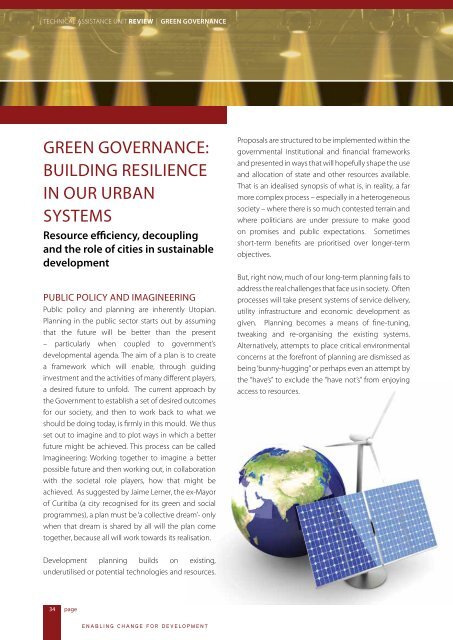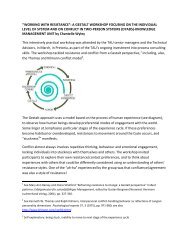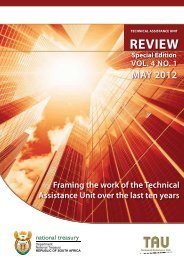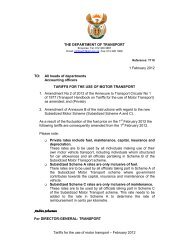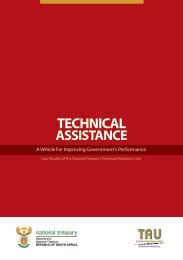Review 3 final 2 - TAU - National Treasury
Review 3 final 2 - TAU - National Treasury
Review 3 final 2 - TAU - National Treasury
Create successful ePaper yourself
Turn your PDF publications into a flip-book with our unique Google optimized e-Paper software.
TECHNICAL ASSISTANCE UNIT REVIEW | Green Governance<br />
Green Governance:<br />
Building resilience<br />
in our urban<br />
systems<br />
Resource efficiency, decoupling<br />
and the role of cities in sustainable<br />
development<br />
PUBLIC POLICY AND IMAGINEERING<br />
Public policy and planning are inherently Utopian.<br />
Planning in the public sector starts out by assuming<br />
that the future will be better than the present<br />
– particularly when coupled to government’s<br />
developmental agenda. The aim of a plan is to create<br />
a framework which will enable, through guiding<br />
investment and the activities of many different players,<br />
a desired future to unfold. The current approach by<br />
the Government to establish a set of desired outcomes<br />
for our society, and then to work back to what we<br />
should be doing today, is firmly in this mould. We thus<br />
set out to imagine and to plot ways in which a better<br />
future might be achieved. This process can be called<br />
Imagineering: Working together to imagine a better<br />
possible future and then working out, in collaboration<br />
with the societal role players, how that might be<br />
achieved. As suggested by Jaime Lerner, the ex-Mayor<br />
of Curitiba (a city recognised for its green and social<br />
programmes), a plan must be ‘a collective dream’- only<br />
when that dream is shared by all will the plan come<br />
together, because all will work towards its realisation.<br />
Proposals are structured to be implemented within the<br />
governmental institutional and financial frameworks<br />
and presented in ways that will hopefully shape the use<br />
and allocation of state and other resources available.<br />
That is an idealised synopsis of what is, in reality, a far<br />
more complex process – especially in a heterogeneous<br />
society – where there is so much contested terrain and<br />
where politicians are under pressure to make good<br />
on promises and public expectations. Sometimes<br />
short-term benefits are prioritised over longer-term<br />
objectives.<br />
But, right now, much of our long-term planning fails to<br />
address the real challenges that face us in society. Often<br />
processes will take present systems of service delivery,<br />
utility infrastructure and economic development as<br />
given. Planning becomes a means of fine-tuning,<br />
tweaking and re-organising the existing systems.<br />
Alternatively, attempts to place critical environmental<br />
concerns at the forefront of planning are dismissed as<br />
being ‘bunny-hugging” or perhaps even an attempt by<br />
the “have’s” to exclude the “have not’s” from enjoying<br />
access to resources.<br />
Development planning builds on existing,<br />
underutilised or potential technologies and resources.<br />
34<br />
page<br />
Enabling change for development


